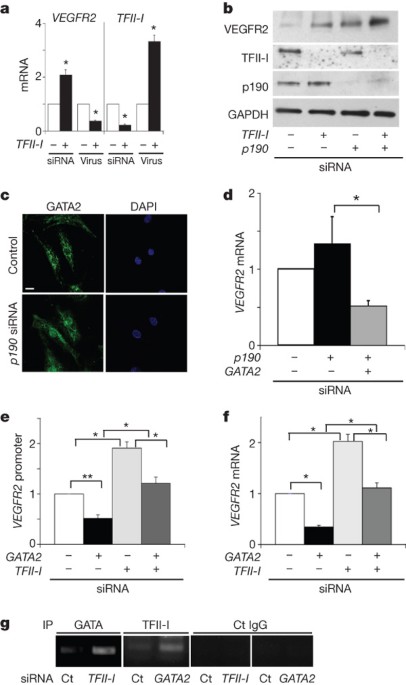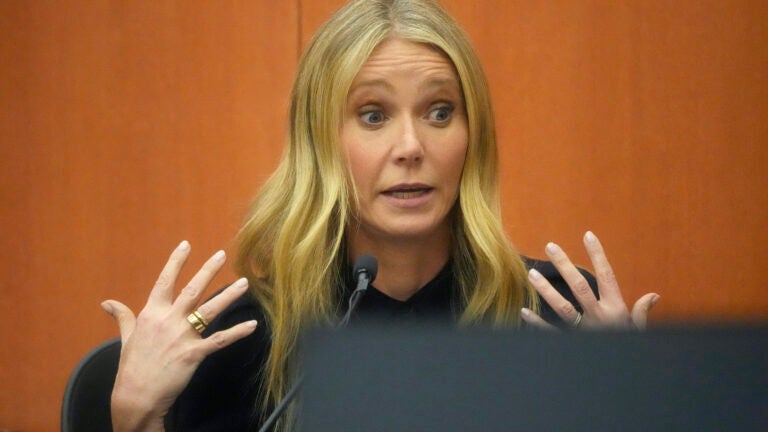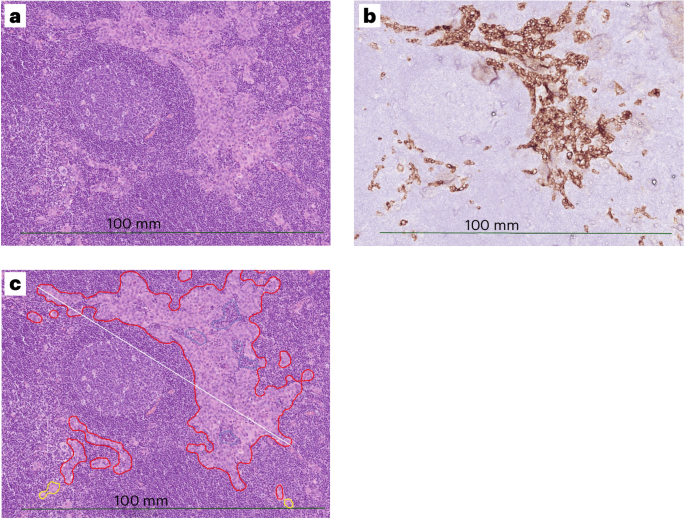
- Select a language for the TTS:
- UK English Female
- UK English Male
- US English Female
- US English Male
- Australian Female
- Australian Male
- Language selected: (auto detect) - EN
Play all audios:
ABSTRACT Angiogenesis is controlled by physical interactions between cells and extracellular matrix as well as soluble angiogenic factors, such as VEGF. However, the mechanism by which
mechanical signals integrate with other microenvironmental cues to regulate neovascularization remains unknown. Here we show that the Rho inhibitor, p190RhoGAP (also known as GRLF1),
controls capillary network formation _in vitro_ in human microvascular endothelial cells and retinal angiogenesis _in vivo_ by modulating the balance of activities between two antagonistic
transcription factors, TFII-I (also known as GTF2I) and GATA2, that govern gene expression of the VEGF receptor _VEGFR2_ (also known as _KDR_). Moreover, this new angiogenesis signalling
pathway is sensitive to extracellular matrix elasticity as well as soluble VEGF. This is, to our knowledge, the first known functional cross-antagonism between transcription factors that
controls tissue morphogenesis, and that responds to both mechanical and chemical cues. Access through your institution Buy or subscribe This is a preview of subscription content, access via
your institution ACCESS OPTIONS Access through your institution Subscribe to this journal Receive 51 print issues and online access $199.00 per year only $3.90 per issue Learn more Buy this
article * Purchase on SpringerLink * Instant access to full article PDF Buy now Prices may be subject to local taxes which are calculated during checkout ADDITIONAL ACCESS OPTIONS: * Log in
* Learn about institutional subscriptions * Read our FAQs * Contact customer support SIMILAR CONTENT BEING VIEWED BY OTHERS THE TRANSCRIPTION FACTOR COMPLEX LMO2/TAL1 REGULATES BRANCHING AND
ENDOTHELIAL CELL MIGRATION IN SPROUTING ANGIOGENESIS Article Open access 04 May 2022 ENDOTHELIAL TIP-CELL POSITION, FILOPODIA FORMATION AND BIOMECHANICS REQUIRE BMPR2 EXPRESSION AND
SIGNALING Article Open access 08 January 2025 HYDROSTATIC PRESSURE DRIVES SPROUTING ANGIOGENESIS VIA ADHERENS JUNCTION REMODELLING AND YAP SIGNALLING Article Open access 03 August 2024
REFERENCES * Ferrara, N., Gerber, H. P. & LeCouter, J. The biology of VEGF and its receptors. _Nature Med._ 9, 669–676 (2003) Article CAS Google Scholar * Ferrara, N., Mass, R. D.,
Campa, C. & Kim, R. Targeting VEGF-A to treat cancer and age-related macular degeneration. _Annu. Rev. Med._ 58, 491–504 (2007) Article CAS Google Scholar * Ingber, D. E. &
Folkman, J. Mechanochemical switching between growth and differentiation during fibroblast growth factor-stimulated angiogenesis _in vitro_: role of extracellular matrix. _J. Cell Biol._
109, 317–330 (1989) Article CAS Google Scholar * Chen, C. S., Mrksich, M., Huang, S., Whitesides, G. M. & Ingber, D. E. Geometric control of cell life and death. _Science_ 276,
1425–1428 (1997) Article CAS Google Scholar * Dike, L. E. et al. Geometric control of switching between growth, apoptosis, and differentiation during angiogenesis using micropatterned
substrates. _In Vitro Cell. Dev. Biol. Anim._ 35, 441–448 (1999) Article CAS Google Scholar * Parker, K. K. et al. Directional control of lamellipodia extension by constraining cell shape
and orienting cell tractional forces. _FASEB J._ 16, 1195–1204 (2002) Article CAS Google Scholar * Matthews, B. D., Overby, D. R., Mannix, R. & Ingber, D. E. Cellular adaptation to
mechanical stress: role of integrins, Rho, cytoskeletal tension and mechanosensitive ion channels. _J. Cell Sci._ 119, 508–518 (2006) Article CAS Google Scholar * Kumar, S. et al.
Viscoelastic retraction of single living stress fibers and its impact on cell shape, cytoskeletal organization, and extracellular matrix mechanics. _Biophys. J._ 90, 3762–3773 (2006) Article
CAS Google Scholar * Moore, K. A. et al. Control of basement membrane remodeling and epithelial branching morphogenesis in embryonic lung by Rho and cytoskeletal tension. _Dev. Dyn._
232, 268–281 (2005) Article CAS Google Scholar * Huang, S. & Ingber, D. E. The structural and mechanical complexity of cell-growth control. _Nature Cell Biol._ 1, E131–E138 (1999)
Article CAS Google Scholar * Folkman, J. & Moscona, A. Role of cell shape in growth control. _Nature_ 273, 345–349 (1978) Article CAS Google Scholar * Folkman, J. & Kalluri, R.
Cancer without disease. _Nature_ 427, 787 (2004) Article CAS Google Scholar * Matsumoto, T. & Claesson-Welsh, L. VEGF receptor signal transduction. _Sci. STKE_ 2001, re21 (2001) CAS
Google Scholar * Wong, C. G., Rich, K. A., Liaw, L. H., Hsu, H. T. & Berns, M. W. Intravitreal VEGF and bFGF produce florid retinal neovascularization and hemorrhage in the rabbit.
_Curr. Eye Res._ 22, 140–147 (2001) Article CAS Google Scholar * Mammoto, A., Huang, S., Moore, K., Oh, P. & Ingber, D. E. Role of RhoA, mDia, and ROCK in cell shape-dependent control
of the Skp2-p27kip1 pathway and the G1/S transition. _J. Biol. Chem._ 279, 26323–26330 (2004) Article CAS Google Scholar * Mammoto, A., Huang, S. & Ingber, D. E. Filamin links cell
shape and cytoskeletal structure to Rho regulation by controlling accumulation of p190RhoGAP in lipid rafts. _J. Cell Sci._ 120, 456–467 (2007) Article CAS Google Scholar * Jiang, W. et
al. An FF domain-dependent protein interaction mediates a signaling pathway for growth factor-induced gene expression. _Mol. Cell_ 17, 23–35 (2005) Article CAS Google Scholar * Jackson,
T. A., Taylor, H. E., Sharma, D., Desiderio, S. & Danoff, S. K. Vascular endothelial growth factor receptor-2: counter-regulation by the transcription factors, TFII-I and TFII-IRD1. _J.
Biol. Chem._ 280, 29856–29863 (2005) Article CAS Google Scholar * Roy, A. L. Biochemistry and biology of the inducible multifunctional transcription factor TFII-I. _Gene_ 274, 1–13 (2001)
Article CAS Google Scholar * Francke, U. Williams–Beuren syndrome: genes and mechanisms. _Hum. Mol. Genet._ 8, 1947–1954 (1999) Article CAS Google Scholar * Roy, A. L. Signal-induced
functions of the transcription factor TFII-I. _Biochim. Biophys. Acta_ 1769, 613–621 (2007) Article CAS Google Scholar * Patterson, C. et al. Cloning and functional analysis of the
promoter for KDR/flk-1, a receptor for vascular endothelial growth factor. _J. Biol. Chem._ 270, 23111–23118 (1995) Article CAS Google Scholar * Minami, T., Rosenberg, R. D. & Aird,
W. C. Transforming growth factor-β1-mediated inhibition of the _flk-1/KDR_ gene is mediated by a 5′-untranslated region palindromic GATA site. _J. Biol. Chem._ 276, 5395–5402 (2001) Article
CAS Google Scholar * Minami, T. et al. Interaction between hex and GATA transcription factors in vascular endothelial cells inhibits _flk-1/KDR_-mediated vascular endothelial growth
factor signaling. _J. Biol. Chem._ 279, 20626–20635 (2004) Article CAS Google Scholar * Cantor, A. B. & Orkin, S. H. Hematopoietic development: a balancing act. _Curr. Opin. Genet.
Dev._ 11, 513–519 (2001) Article CAS Google Scholar * Grogan, J. L. & Locksley, R. M. T helper cell differentiation: on again, off again. _Curr. Opin. Immunol._ 14, 366–372 (2002)
Article CAS Google Scholar * Pai, S. Y., Truitt, M. L. & Ho, I. C. GATA-3 deficiency abrogates the development and maintenance of T helper type 2 cells. _Proc. Natl Acad. Sci. USA_
101, 1993–1998 (2004) Article CAS Google Scholar * Kouros-Mehr, H., Slorach, E. M., Sternlicht, M. D. & Werb, Z. GATA-3 maintains the differentiation of the luminal cell fate in the
mammary gland. _Cell_ 127, 1041–1055 (2006) Article CAS Google Scholar * Su, Z. J. et al. A vascular cell-restricted RhoGAP, p73RhoGAP, is a key regulator of angiogenesis. _Proc. Natl
Acad. Sci. USA_ 101, 12212–12217 (2004) Article CAS Google Scholar * Arthur, W. T., Petch, L. A. & Burridge, K. Integrin engagement suppresses RhoA activity via a c-Src-dependent
mechanism. _Curr. Biol._ 10, 719–722 (2000) Article CAS Google Scholar * Robinson, C. J. & Stringer, S. E. The splice variants of vascular endothelial growth factor (VEGF) and their
receptors. _J. Cell Sci._ 114, 853–865 (2001) CAS Google Scholar * Sheibani, N. & Frazier, W. A. Down-regulation of platelet endothelial cell adhesion molecule-1 results in
thrombospondin-1 expression and concerted regulation of endothelial cell phenotype. _Mol. Biol. Cell_ 9, 701–713 (1998) Article CAS Google Scholar * Numaguchi, Y. et al.
Caldesmon-dependent switching between capillary endothelial cell growth and apoptosis through modulation of cell shape and contractility. _Angiogenesis_ 6, 55–64 (2003) Article CAS Google
Scholar * Polte, T. R., Eichler, G. S., Wang, N. & Ingber, D. E. Extracellular matrix controls myosin light chain phosphorylation and cell contractility through modulation of cell shape
and cytoskeletal prestress. _Am. J. Physiol. Cell Physiol._ 286, C518–C528 (2004) Article CAS Google Scholar * Pierce, E. A., Avery, R. L., Foley, E. D., Aiello, L. P. & Smith, L. E.
Vascular endothelial growth factor/vascular permeability factor expression in a mouse model of retinal neovascularization. _Proc. Natl Acad. Sci. USA_ 92, 905–909 (1995) Article CAS
Google Scholar * Stalmans, I. et al. Arteriolar and venular patterning in retinas of mice selectively expressing VEGF isoforms. _J. Clin. Invest._ 109, 327–336 (2002) Article CAS Google
Scholar * Mammoto, T. et al. Angiopoietin-1 requires p190RhoGAP to protect against vascular leakage _in vivo_ . _J. Biol. Chem._ 282, 23910–23918 (2007) Article CAS Google Scholar *
Singh, H., Medina, K. L. & Pongubala, J. M. Contingent gene regulatory networks and B cell fate specification. _Proc. Natl Acad. Sci. USA_ 102, 4949–4953 (2005) Article CAS Google
Scholar * Swiers, G., Patient, R. & Loose, M. Genetic regulatory networks programming hematopoietic stem cells and erythroid lineage specification. _Dev. Biol._ 294, 525–540 (2006)
Article CAS Google Scholar * Gottgens, B. et al. Establishing the transcriptional programme for blood: the SCL stem cell enhancer is regulated by a multiprotein complex containing Ets and
GATA factors. _EMBO J._ 21, 3039–3050 (2002) Article CAS Google Scholar * Engler, A. J., Sen, S., Sweeney, H. L. & Discher, D. E. Matrix elasticity directs stem cell lineage
specification. _Cell_ 126, 677–689 (2006) Article CAS Google Scholar * Clark, E. R. & Clark, E. L. Microscopic observations on the growth of blood capillaries in the living mammal.
_Am. J. Anat._ 64, 251–301 (1939) Article Google Scholar * Carmeliet, P. & Tessier-Lavigne, M. Common mechanisms of nerve and blood vessel wiring. _Nature_ 436, 193–200 (2005) Article
CAS Google Scholar * Pelham, R. J. & Wang, Y. Cell locomotion and focal adhesions are regulated by substrate flexibility. _Proc. Natl Acad. Sci. USA_ 94, 13661–13665 (1997) Article
CAS Google Scholar * Wang, N. et al. Cell prestress. I. Stiffness and prestress are closely associated in adherent contractile cells. _Am. J. Physiol. Cell Physiol._ 282, C606–C616 (2002)
Article CAS Google Scholar * Yung, C. W. et al. Transglutaminase crosslinked gelatin as a tissue engineering scaffold. _J. Biomed. Mater. Res. A_ 83, 1039–1046 (2007) Article CAS Google
Scholar * Connor, K. M. et al. Increased dietary intake of Ω-3-polyunsaturated fatty acids reduces pathological retinal angiogenesis. _Nature Med._ 13, 868–873 (2007) Article CAS Google
Scholar Download references ACKNOWLEDGEMENTS We thank T. Polte, E. Pravda, M. de Bruijn and K. Johnson for their technical suggestions and assistance, T. Nakano and H. Sabe for providing
plasmids, the National Institutes of Health (NIH) for providing VEGF, and D. Weitz for providing assistance with rheometry measurements. This work was supported by funds from the NIH (to
D.E.I., L.E.H.S. and K.M.C.), V. Kann Rasmussen Foundation (to L.E.H.S.), Children’s Hospital Mental Retardation and Developmental Disabilities Research Center (to L.E.H.S.), a Research to
Prevent Blindness Lew Wasserman Merit Award (to L.E.H.S.), American Heart Association (to A.M.), and a Children’s Hospital House Officer Development Award (to A.M.); D.E.I. is a recipient of
a DoD Breast Cancer Innovator Award. AUTHOR CONTRIBUTIONS A.M. conceived the experiments, performed experiments, designed research and analysed data with assistance from K.M.C., T.M.,
C.W.Y., D.H., C.M.A., G.M., L.E.H.S. and D.E.I. A.M. wrote the manuscript with D.E.I., with input from L.E.H.S. AUTHOR INFORMATION Author notes * Gustavo Mostoslavsky Present address:
Present address: Department of Medicine, Boston University School of Medicine, Boston, Massachusetts 02118, USA., AUTHORS AND AFFILIATIONS * Departments of Pathology & Surgery,, Vascular
Biology Program, Akiko Mammoto, Tadanori Mammoto, Chong Wing Yung, Dongeun Huh & Donald E. Ingber * Department of Ophthalmology, Children’s Hospital and Harvard Medical School, Boston,
Massachusetts 02115, USA, Kip M. Connor, Christopher M. Aderman & Lois E. H. Smith * Department of Genetics, Harvard Medical School, Harvard Institute of Medicine, Boston, Massachusetts
02215, USA, Gustavo Mostoslavsky * Wyss Institute for Biologically Inspired Engineering and Harvard School of Engineering and Applied Sciences, Cambridge, Massachusetts 02138, USA , Donald
E. Ingber Authors * Akiko Mammoto View author publications You can also search for this author inPubMed Google Scholar * Kip M. Connor View author publications You can also search for this
author inPubMed Google Scholar * Tadanori Mammoto View author publications You can also search for this author inPubMed Google Scholar * Chong Wing Yung View author publications You can also
search for this author inPubMed Google Scholar * Dongeun Huh View author publications You can also search for this author inPubMed Google Scholar * Christopher M. Aderman View author
publications You can also search for this author inPubMed Google Scholar * Gustavo Mostoslavsky View author publications You can also search for this author inPubMed Google Scholar * Lois E.
H. Smith View author publications You can also search for this author inPubMed Google Scholar * Donald E. Ingber View author publications You can also search for this author inPubMed Google
Scholar CORRESPONDING AUTHOR Correspondence to Donald E. Ingber. SUPPLEMENTARY INFORMATION SUPPLEMENTARY INFORMATION This file contains Supplementary Figures S1-S13 with Legends and
Supplementary Tables S1 and S2 (PDF 6181 kb) POWERPOINT SLIDES POWERPOINT SLIDE FOR FIG. 1 POWERPOINT SLIDE FOR FIG. 2 POWERPOINT SLIDE FOR FIG. 3 POWERPOINT SLIDE FOR FIG. 4 POWERPOINT
SLIDE FOR FIG. 5 RIGHTS AND PERMISSIONS Reprints and permissions ABOUT THIS ARTICLE CITE THIS ARTICLE Mammoto, A., Connor, K., Mammoto, T. _et al._ A mechanosensitive transcriptional
mechanism that controls angiogenesis. _Nature_ 457, 1103–1108 (2009). https://doi.org/10.1038/nature07765 Download citation * Received: 02 October 2008 * Accepted: 31 December 2008 * Issue
Date: 26 February 2009 * DOI: https://doi.org/10.1038/nature07765 SHARE THIS ARTICLE Anyone you share the following link with will be able to read this content: Get shareable link Sorry, a
shareable link is not currently available for this article. Copy to clipboard Provided by the Springer Nature SharedIt content-sharing initiative








